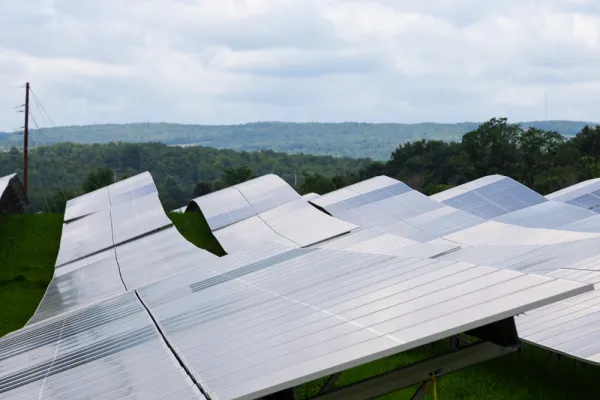Energy from the Sun: Collaborative Solar Facility Goes Online in Maine
Sustainability
Facility is a first-of-its-kind collaboration among five leading New England liberal arts colleges

Published November 15, 2021
An innovative collaborative energy project has started delivering electricity to five New England colleges—and to tens of thousands of students, staff and faculty—as a new solar energy facility has gone online in Farmington, Maine.
Launched in 2018, the New England College Renewable Partnership is a first-of-its-kind collaboration among five leading New England liberal arts institutions: Amherst, Bowdoin, Hampshire, Smith and Williams.
Over the past three years, the colleges have contracted with a subsidiary of NextEra Energy Resources, a leading clean energy company, to construct a utility-scale solar power facility that annually will create enough electricity to power about 17,000 New England homes. Competitive Energy Services acted as an adviser on the project.
Each of the colleges is purchasing zero-carbon electricity from the Farmington facility to reduce carbon emissions from campus electricity use.
The New England College Renewable Partnership is important both for what it does, and for what it represents.
On a practical level:
- The Farmington facility is creating new solar electricity in New England—not an easy accomplishment, given the area’s geography and terrain.
- The partnership helps each school manage costs by “locking in” the price of electricity for the next 20 years.
- The new solar energy generated by the facility will have a significant impact on sustainability, moving each of the five campuses closer to their climate action goals.
The Farmington project has already had a significant economic impact, as well:
- The project created approximately 500 temporary construction jobs.
- It will generate tax revenue of nearly $17 million over its 30-year lifespan.
- It has generated capital expenditures of approximately $150 million.
At a strategic level, the New England College Renewable Partnership—the first such collaboration among New England schools—is consistent with collaborations occurring in the corporate sphere. The colleges collaborating around the Farmington effort hope that their partnership will inspire other institutions to work together on similar projects, allowing them to take advantage of shared efficiencies and economies of scale.
The Impact at Smith College
The NEC Renewable Partnership significantly advances Smith’s long-term commitment to sustainability while also providing immediate benefits to the college.
“Collaborations like these are rare, but hold great promise for innovation in higher education,” said Smith College President Kathleen McCartney. “This groundbreaking partnership reflects Smith’s strong commitment to leadership and action regarding environmental sustainability, and moves us significantly closer to reaching our goal of becoming carbon neutral by 2030. Given the devastating effects that climate change is having across the world, I am proud that Smith is collaborating with peer colleges to move us toward solutions.”
Now that the Farmington facility is online, all of Smith’s purchased electricity is coming from New England. (The rest of Smith’s electricity—some 70%—is generated on campus.)
In addition, the project allows Smith to reduce its greenhouse gas emissions by 10%, bringing Smith significantly closer to its goal of achieving carbon neutrality by 2030.
Dano Weisbord, Smith’s associate vice president for campus planning and sustainability, noted that the NEC Partnership also provided valuable educational opportunities for students. Weisbord cited, in particular, a summer research team of Smith, Amherst and Williams students who created an informational website about the Farmington project. “At Smith, the entire campus is a classroom,” Weisbrod said, “and this project has allowed us to create a collaborative classroom that extends all the way to Farmington, Maine.”
Photo credit: NextEra Energy Resources